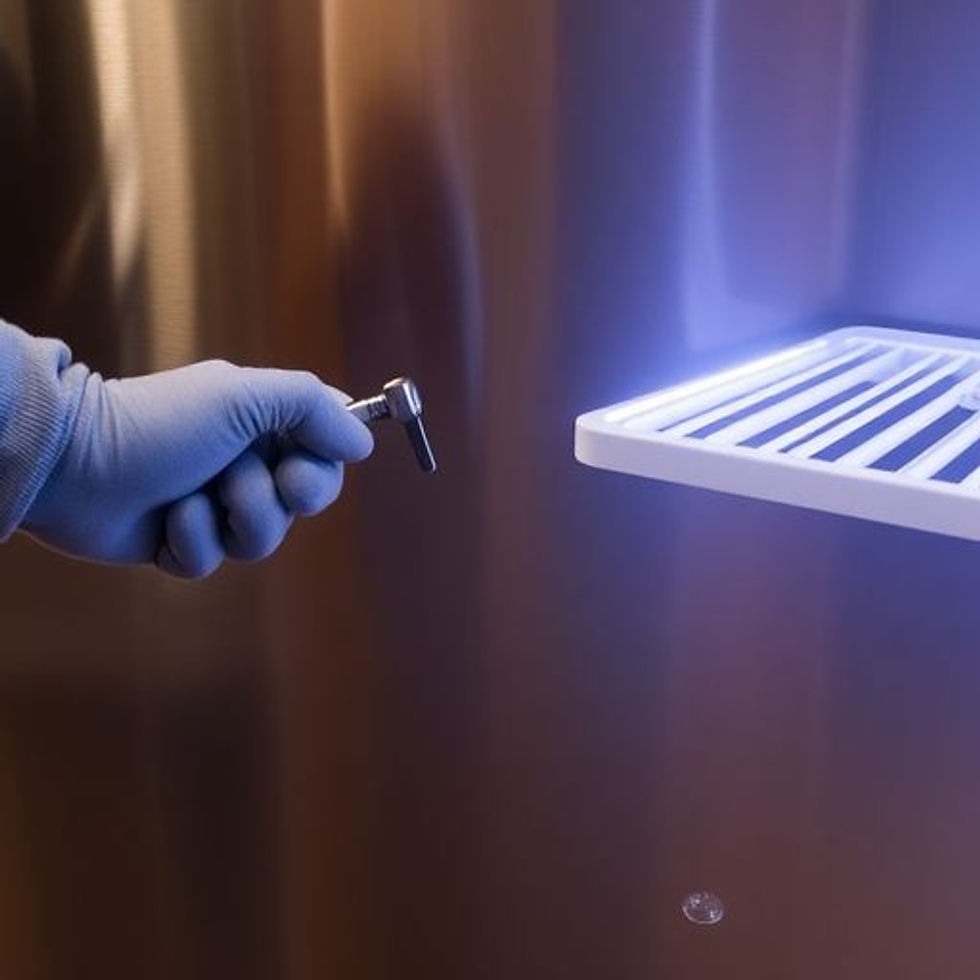5 Expert Tips for Hassle-Free Fridge Repairs in Toronto
- ZIv H

- Jul 17
- 7 min read
Fridge breakdowns are the worst. One day, you’re fine; next, your food’s going south fast. If you’re hunting for fridge repairs toronto that don’t cost an arm and a leg or give you a headache, these tips should help. I’ve tried some of this stuff myself, so you don’t have to learn the hard way.
Key Takeaways
Check the evaporator fan motor for odd noises or blockages to keep airflow steady.
Clean the condenser coils regularly so your fridge doesn’t have to work extra hard.
Test and adjust the refrigerator thermostat to stop hot spots and spoiled food.
Inspect and replace a cracked or loose door gasket seal to lock in cold air.
Verify the water inlet valve is clicking on and off right to avoid leaks and ice maker drama.
1. Evaporator Fan Motor
Okay, so your fridge is making weird noises, or worse, it's not cooling properly? Don't panic yet! One of the usual suspects is the evaporator fan motor. This little guy is responsible for circulating air over the cooling coils and then throughout your fridge. When it fails, things can get... warm. And nobody wants a warm fridge, unless you're intentionally trying to ferment something.
Here's the deal:
Listen closely: Is there a loud buzzing, grinding, or clicking sound coming from inside the freezer? That's often a dead giveaway.
Check for ice buildup: Sometimes, excessive ice can block the fan, causing it to strain and eventually fail. If you see a glacier in your freezer, that's your first problem.
Spin it manually: With the fridge unplugged (safety first, folks!), try to spin the fan blade by hand. If it's stiff or doesn't spin freely, the motor is likely shot.
Replacing the evaporator fan motor isn't rocket science, but it does require some basic tools and a bit of patience. If you're not comfortable working with electrical components, it's best to call in a pro. Trust me, electrocution is not a fun way to spend an afternoon. You can find refrigerator repair services in Toronto that can handle this for you.
Here's a quick troubleshooting table:
Symptom | Possible Cause | Solution |
|---|---|---|
Loud buzzing | Worn-out motor bearings | Replace the motor |
No cooling | Fan not running | Check for ice buildup; replace motor if necessary |
Intermittent cooling | Fan runs sporadically | Could be a failing motor or a problem with the fridge thermostat |
2. Condenser Coils
Alright, let's talk about the unsung heroes behind your fridge: the condenser coils. These guys are usually located at the back or bottom of your fridge, and their job is to release heat. Think of them as the fridge's personal radiator, except instead of keeping your car from overheating, they're keeping your milk from turning into yogurt.
If your fridge is struggling to stay cool, or you notice it's running louder than usual, dirty condenser coils might be the culprit. Dust, pet hair, and general household grime can build up on these coils, insulating them and preventing them from doing their job efficiently. This forces your fridge to work harder, which can lead to higher energy bills and, eventually, a breakdown.
Cleaning them is surprisingly easy, though. Unplug your fridge (safety first!), locate the coils, and use a vacuum cleaner with a brush attachment to gently remove the accumulated dust and debris. For stubborn grime, a soft brush and some warm, soapy water can do the trick. Just make sure everything is completely dry before plugging the fridge back in. Think of it as giving your fridge a spa day – it'll thank you for it.
Keeping your condenser coils clean is one of the easiest and most effective ways to maintain your fridge's performance and extend its lifespan. It's like flossing for your fridge – not the most glamorous task, but definitely worth it in the long run.
Here's a quick checklist for keeping those coils in tip-top shape:
Unplug the fridge before cleaning.
Use a vacuum with a brush attachment for initial cleaning.
Wipe down with a damp cloth for stubborn dirt.
Ensure the coils are completely dry before plugging the fridge back in.
Regular maintenance of the door gasket seal can also help improve your fridge's efficiency. Ignoring these coils is like ignoring that weird noise your car is making – it's probably not going to fix itself, and it'll likely get worse over time. So, grab your vacuum, show those coils some love, and enjoy a cooler, happier fridge.
3. Refrigerator Thermostat
Okay, so your fridge is acting up, and you're thinking it might be the thermostat. Good call! The thermostat is basically the brain of your fridge, telling it when to cool down. If it's on the fritz, things can get pretty weird. One day your milk is frozen solid, the next it's lukewarm. Fun times!
A faulty thermostat can lead to inconsistent temperatures, which is a real pain.
Here's the deal: sometimes, the thermostat just needs a little nudge (not literally, please). Other times, it's time for a replacement. Figuring out which is which can save you some serious cash. Before you call in the pros for refrigerator repair services, let's see if we can troubleshoot this thing ourselves.
Think of your fridge thermostat like a grumpy old man. Sometimes it just needs a little tap to get going, but other times, it's just plain broken and needs to be replaced. Either way, dealing with it is part of the joy of homeownership.
Here's a simple way to test it:
Locate the thermostat. It's usually inside the fridge, near the temperature control knob.
Turn the thermostat from the highest to the lowest setting and listen for a click. If you don't hear a click, that's a bad sign.
Use a multimeter to test the continuity of the thermostat. If there's no continuity, it's likely kaput.
If you're not comfortable messing with electrical components, don't sweat it. Call a qualified technician. It's better to be safe than sorry (and electrocuted).
4. Door Gasket Seal
Okay, so your fridge isn't keeping things as chilly as it should? Before you start blaming the compressor or some other fancy part, take a good, hard look at the door gasket. This rubber seal is your fridge's first line of defense against warm air sneaking in and turning your milk lukewarm. If it's cracked, torn, or just plain dirty, you're basically throwing money out the window in wasted energy.
A faulty door gasket forces your fridge to work overtime.
Here's a quick rundown of what to look for:
Visual Inspection: Check for any visible damage. Cracks, tears, or even just a build-up of grime can compromise the seal.
The Paper Test: Close the door on a piece of paper. If you can pull the paper out easily with the door closed, the seal isn't tight enough. Repeat this test around the entire door.
The Flashlight Test: Have someone shine a flashlight around the outside of the closed door while you're inside the fridge. If you see light peeking through, you've got a leak.
If your gasket is just dirty, give it a good scrub with warm, soapy water. But if it's damaged, you'll need to replace it. Luckily, this is a pretty straightforward repair you can often do yourself. You can find replacement GE refrigerator issues at most appliance parts stores in Toronto, like Reliable Parts or Amre Supply. Just make sure you get the right one for your fridge model!
Replacing a fridge door gasket is like giving your fridge a new lease on life. It's a small investment that can save you big bucks on your energy bill and keep your food fresher for longer. Plus, it's way cheaper than buying a whole new fridge!
5. Water Inlet Valve
So, your fridge isn't dispensing water or making ice? Chances are, the water inlet valve is playing hard to get. This little guy controls the flow of water into your fridge, and when it malfunctions, things can get pretty dry (or not icy, at least).
First things first, locate the valve. It's usually at the back of the fridge, near the bottom. Before you even think about touching it, cut off the water supply. Trust me, you don't want a surprise indoor water feature.
Now, let's get down to business:
Check for kinks or clogs in the water line. Sometimes, it's just a simple blockage causing the issue. Straighten out any kinks and clear any debris.
Test the valve with a multimeter. If it's not getting power, the problem might be electrical. Time to call in a pro, unless you're secretly an electrician.
Inspect the valve for any visible damage. Cracks or leaks are a dead giveaway that it needs replacing.
Replacing the water inlet valve isn't rocket science, but it does require some basic skills and the right tools. If you're not comfortable doing it yourself, don't hesitate to call a qualified technician. Remember, a small repair is better than a flooded kitchen.
And hey, while you're at it, why not check out some fridge repair in Etobicoke? You never know what other gremlins might be lurking in your appliance.
The water inlet valve on your washer controls the flow of water. If it clogs or leaks, your machine might fill too slowly or not at all. It’s small but mighty—without it, laundry won’t get clean. Act fast. Visit Appliance Repair Near Me Inc. to get help now.
## Conclusion
Alright, you’ve made it through five tips for hassle-free fridge repairs in Toronto. Next time your fridge stops humming, check reviews, ask the right questions, compare prices, pick a local tech, and know when it’s time to call a pro. That way you’ll skip the frost-bitten lettuce and surprise drips at 2 a.m. Seriously, your nose and sanity will thank you. Now go grab something cold (your fridge should be ready), sit back, and relax.
Frequently Asked Questions
How do I know if my evaporator fan motor is broken?
You might hear strange noises or notice your fridge is warm. If the fan doesn’t spin when the door is open, it’s a good sign the motor needs help.
What’s the easiest way to clean condenser coils?
Unplug your fridge, find the coils (usually at the back or bottom), and use a soft brush or vacuum to remove dust. Do this every six months.
Can I fix a fridge thermostat myself?
You can try turning the dial or replacing the knob. If that doesn’t work, it’s safer to call a pro. Mistakes can make your fridge stop cooling.
Why is my fridge leaking water around the door seal?
A worn-out gasket lets warm air in and cold air out. This makes frost melt inside, then drip. Replacing the gasket usually stops the leak.
How often should I replace the door gasket?
Check it every year. If it’s cracked or won’t close tight, swap it out. A fresh gasket keeps your fridge cold and cuts down on power bills.
When should I call a pro for a water inlet valve issue?
If your ice maker or dispenser runs dry or keeps flowing, call a technician. Working on water lines can be messy and cause leaks.













Comments